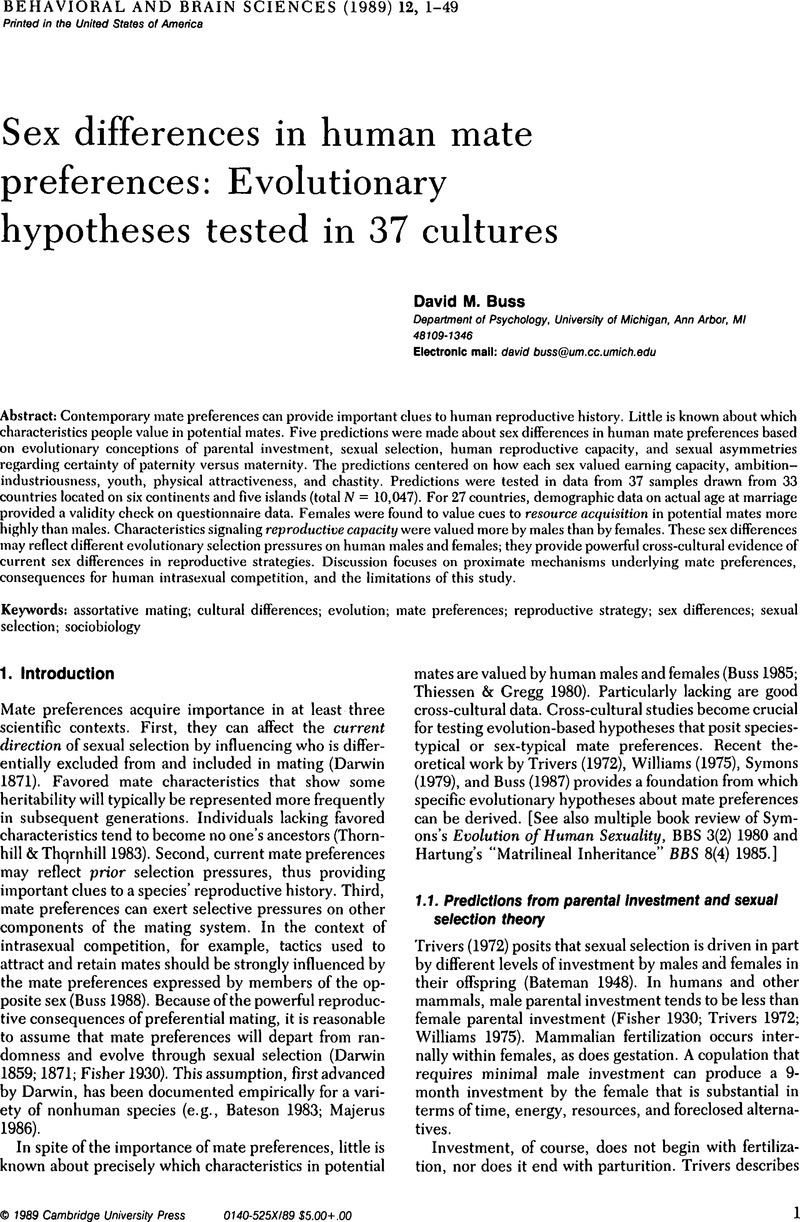Crossref Citations
This article has been cited by the following publications. This list is generated based on data provided by Crossref.
Rajecki, D. W.
and
Rasmussen, Jeffrey Lee
1992.
Personal ads as deviant and unsatisfactory: Support for evolutionary hypotheses.
Behavioral and Brain Sciences,
Vol. 15,
Issue. 1,
p.
107.
Crawford, Charles
1992.
Sex differences in age preferences for mates: Primary and secondary predictions from evolutionary theory.
Behavioral and Brain Sciences,
Vol. 15,
Issue. 1,
p.
97.
Stephan, Walter G.
1992.
Sexual motivation, patriarchy and compatibility.
Behavioral and Brain Sciences,
Vol. 15,
Issue. 1,
p.
111.
Bayer, Betty M.
1992.
On the separation of reproduction from mating preferences.
Behavioral and Brain Sciences,
Vol. 15,
Issue. 1,
p.
92.
Stevens, Gillian
1992.
Mortality and age-specific patterns of marriage.
Behavioral and Brain Sciences,
Vol. 15,
Issue. 1,
p.
112.
Russell, P. A.
1992.
The evolutionary model is synthetic not heuristic.
Behavioral and Brain Sciences,
Vol. 15,
Issue. 1,
p.
108.
Borkenau, Peter
1992.
Age preferences: The crucial studies have yet to be done.
Behavioral and Brain Sciences,
Vol. 15,
Issue. 1,
p.
93.
Grammer, Karl
1992.
Variations on a theme: Age dependent mate selection in humans.
Behavioral and Brain Sciences,
Vol. 15,
Issue. 1,
p.
100.
Dewsbury, Donald A.
1992.
Continuing a long tradition.
Behavioral and Brain Sciences,
Vol. 15,
Issue. 1,
p.
98.
Alley, Thomas R.
1992.
Perceived age, physical attractiveness and sex differences in preferred mates' ages.
Behavioral and Brain Sciences,
Vol. 15,
Issue. 1,
p.
92.
Simpson, Jeffry A.
1992.
Half a theory and half the data for half the people?.
Behavioral and Brain Sciences,
Vol. 15,
Issue. 1,
p.
109.
Levinger, George
and
Kirkpatrick, Lee A.
1992.
Biological versus social psychological bases of mate selection.
Behavioral and Brain Sciences,
Vol. 15,
Issue. 1,
p.
103.
Broude, Gwen J.
1992.
The May-September algorithm meets the 20th century actuarial table.
Behavioral and Brain Sciences,
Vol. 15,
Issue. 1,
p.
94.
Dupré, John
1992.
Arbitrariness and bias in evolutionary speculation.
Behavioral and Brain Sciences,
Vol. 15,
Issue. 1,
p.
98.
Funder, David C.
1992.
Toward a nonarbitrary social psychology.
Behavioral and Brain Sciences,
Vol. 15,
Issue. 1,
p.
99.
Glenn, Norval D.
1992.
Toward a more complete integration of evolutionary and other perspectives on age preferences in mates.
Behavioral and Brain Sciences,
Vol. 15,
Issue. 1,
p.
100.
Byrne, Donn
and
Kelley, Kathryn
1992.
Differential age preferences: The need to test evolutionary versus alternative conceptualizations.
Behavioral and Brain Sciences,
Vol. 15,
Issue. 1,
p.
96.
Sloman, Steven A.
and
Sloman, Leon
1992.
What does evolution tell us about age preferences?.
Behavioral and Brain Sciences,
Vol. 15,
Issue. 1,
p.
110.
Wallen, Kim
1992.
Evolutionary hypothesis testing: Consistency is not enough.
Behavioral and Brain Sciences,
Vol. 15,
Issue. 1,
p.
118.
Thornhill, Nancy Wilmsen
and
Thornhill, Patrick A. A.
1992.
The preferred age of a potential mate reflects evolved male sexual psychology.
Behavioral and Brain Sciences,
Vol. 15,
Issue. 1,
p.
114.



